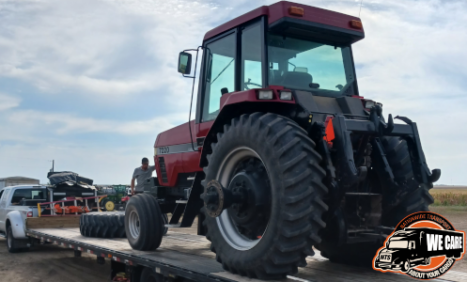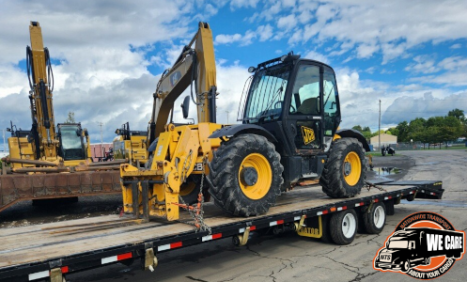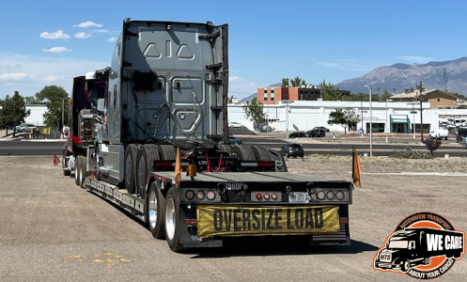In the logistics industry, you must rely on the tools to transport goods safely and efficiently. Flatbed trailers are an essential component in successful logistics, and different types of flatbeds allow for easy loading and unloading and transportation of items too long, tall or heavy for enclosed trailers.
Familiarizing yourself with the various types of flatbed trailers has many benefits, including choosing the right option for your needs. With the right equipment, you can save money, increase transport efficiency and ensure safe delivery compliant with various transportation regulations.
What Is a Flatbed Trailer?
A flatbed trailer is a type of trailer with a flat deck and no sides or roof. Flatbeds fall into a class of semi-trailers with a unique bed design, often used to transport bulky or heavy cargo. They’re particularly well suited to asymmetrical or wide loads that may not fit in a walled or covered trailer.
There are many types of flatbeds, and they come in various weights and sizes to suit a range of applications. A flatbed’s structure simplifies cargo loading and unloading, as forklift trucks and other loading devices can work from any side of the vehicle.
Common Flatbed Trailer Dimensions
Although different types of flatbed trailers come in various sizes and dimensions depending on the model and manufacturer, knowing the standard dimensions can help you decide whether a flatbed is the right equipment. Typical flatbed trailer dimensions include the following:
- Maximum cargo width: 102 inches.
- Maximum cargo weight: 48,000 pounds.
- Maximum cargo height: 102 inches.
- Maximum cargo length: Between 48 and 53 feet.
Although the above dimensions refer to a typical flatbed, trailer dimensions vary. Always check the specifications with the manufacturer to ensure that any trailer you use meets your needs.
The Benefits of Flatbed Trailers
Flatbeds are a popular choice for transporting heavy loads as they offer significant benefits, including the following:
- Loading and unloading: As flatbed trailers have no doors, roof or sides, they have a large surface area, making manual or mechanical loading and unloading easy. You can save time safely loading and securing your cargo with a streamlined experience.
- Cleaning and maintenance: Flatbed trailers are characterized by their open decks, making them easier to maintain and clean than other truck options.
- Storage space: Flatbeds offer considerable storage space, allowing drivers to make fewer trips when transporting cargo.
- Delivery times: Reducing driving times leads to more efficient delivery turnaround. You can also expect cost savings due to reduced fuel consumption.
8 Different Types of Flatbed Trailers
There are several types of flatbeds, each suited to a specific purpose. Understanding how the different flatbed types optimize your workflow is essential to choosing the right option for your application. Some common types of flatbeds include the following:
1. Standard Flatbed
A standard flatbed is the most common type, often used for hauling cargo such as machinery and lumber. This option is favored across the country for open-deck freight. It has no frills attached and provides several transportation options for many applications.
Standard flatbeds have damps, a rack and stake pockets to secure a load during transit.
2. Lowboy Trailer
Lowboy flatbeds have a lowered bed in front of the rear axles, allowing for the transportation of tall and heavy loads such as machinery and construction equipment. They commonly sit lower than standard trailers and have two drops in height to accommodate cargo too tall for standard trailers.
Lowboys have lower ground clearance than standard trailers. They can have a well between the trailer and tractor axles to carry high cargo.
3. Removable Gooseneck
As the name suggests, the removable gooseneck (RGN) has a removable gooseneck and a drop deck, making them versatile options for long and tall loads, such as construction equipment and machinery. RGNs are detachable — you can drop the trailer to the ground to form a ramp to drive heavy equipment onto the deck.
In short, RGNs let you carry loads unsuited to standard trailers. You can attach a bulkhead to the front of the trailer to secure your load, and the unique design ensures quick loading and unloading of heavy cargo. The RGN is a popular option nationwide due to its versatility in transporting loads of various dimensions.
4. Drop Deck
Drop deck trailers — also known as step decks — have a top and bottom deck, and are often used to transport cargo that’s too wide or tall for other flatbed options. It has a bed design featuring a deck that drops lower than standard flatbeds to accommodate elevated loads under height restrictions.
The deck design also allows for easy loading and unloading of large and heavy cargo, making it a popular option for transporting equipment like tractors.
5. Double Drop
Double drop trailers have a front and back deck and a well in the middle. The first deck is close to ground level, and the second is slightly higher, so you can load quickly with ramps. They let you load oversize freight and items up to 10 feet tall without worrying about low bridges and headroom restrictions.
You may require cranes and other loading equipment and have a safety rack for transporting tall items.
6. Extendable Drop Deck
This type of flatbed is similar to the drop deck in design but has an extendable deck to accommodate longer loads. These trailers are preferred for transporting loads too long to fit onto other flatbeds, as they can haul cargo such as pipes and wind turbine blades without overhang. However, large loads may still require a permit and escort vehicle, depending on the payload.
7. Stretch Single-Drop Deck
These trailers feature a unique design, with a single drop deck and a long stretch between the cap and the rear. They have ramps for easy loading, and the deck aligns with the ground to improve accessibility when transporting heavy cargo. They’re ideal for heavy loads, low bridges and areas with height restrictions.
Stretch single-drop deck trailers are a safe transportation option, as the bed design focuses on even distributing heavy loads across the trailer’s length.
8. Side Kit
Side kits — also known as racks or top tarps — have a unique bed design installed over several panels. Unlike other types of flatbeds, they have sides to protect cargo from the elements while in transit. They are robust and easy to install and provide a fantastic option for hauling various types of freight in inclement weather.
How to Choose the Right Type of Flatbed
With different flatbed trailer options with various applications, choosing the right choice for your needs is essential. Many industries rely on different types of flatbeds to ensure optimal performance, and many choose the type of flatbed they use based on the type of cargo they need to transport. Some common considerations when choosing a flatbed include the following:
- Load capacity: One of the most important considerations is how much weight and height you need to transport. Ensure you choose a flatbed that can handle the dimensions and weight of your cargo.
- Budget: Your budget can be a deciding factor in the type of trailer you choose. Consider how much you can spend on a flatbed, and find one that suits your needs and budget.
- Maintenance: Some trailer options require more maintenance than others. Consider how many trips your trailer will make and what that translates to regarding maintenance requirements.
Whatever your hauling requirements, consider partnering with a professional flatbed hauling service to ensure the quality and efficiency of your flatbed freight logistics and find the right flatbed solution for your unique needs.
Trust Nationwide Transport Services for Flexible Flatbed Transport Solutions
Choosing the correct type of flatbed is one small but vital part of flatbed trucking logistics. Nationwide Transport Services has the flexibility, skills and knowledge to help you find the right logistics solutions. When you partner with us, we assign you a load specialist to handle every aspect of your flatbed transport, including taking orders, route coordination and following up on the status of your freight.
Nationwide Transport Services has ranked on Inc. 5000’s fastest-growing U.S. privately held companies for the past four years, and we pride ourselves on or ability to find unique solutions for our clients. Reach out to us to learn more about flatbed freight logistics, or request a free quote and start your journey with us today.


